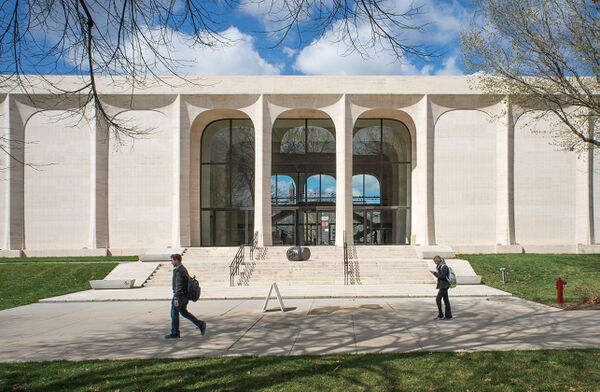Philip Cortelyou Johnson (1906-2005), Architect
DBA: Philip C. Johnson, Architect; Johnson Burgee, Architects; Philip Johnson - Alan Richie Architects
Born in 1906 in Cleveland, Ohio, Philip Johnson was the first director of the Architecture Department at the Museum of Modern Art. While there, in 1932, he was curator of the exhibit he called “The International Style: Architecture Since 1922,” which together with the exhibit catalog, written with Henry-Russell Hitchcock, introduced Americans to the modern movement and the European architects who were at its core—Mies van der Rohe, Walter Gropius, and Le Corbusier. In 1949 Johnson designed his famous Glass House for his masters thesis, which notoriety did much to bring modern design to the forefront of elite taste. His sole commission in Nebraska was the Sheldon Memorial Art Gallery in Lincoln. He died at the age of 98 in 2005.[2][3]
This page is a contribution to the publication, Place Makers of Nebraska: The Architects. See the format and contents page for more information on the compilation and page organization.
Contents
[hide]Local Professional Associations
1960: Registered Professional Architect, Nebraska, A-497; January 16, 1960.[4]
1961-1963: associated with Hazen & Robinson, local coordinating architects for the Sheldon Art Gallery.[10]
1963: Nebraska license expired, December 31, 1963.[4]
Nebraska Buildings & Projects
Sheldon Memorial Art Gallery - Sheldon Museum of Art (1958-1963), 12th & R, University of Nebraska City Campus, Lincoln, Nebraska.[5][6][7][8][9][11:57][12:108-109][a][b][c]
Notes
a. Dale L. Gibbs asserts that this was possibly Johnson’s favorite building (from ongoing conversations with Johnson, whom Gibbs studied under at Yale). It was the first commission for which he was solely responsible as an architect, and he simultaneously used the façade of the Sheldon as the basis for the Lake Pavilion (1962) he built at his Glass House (1949) residence in New Canaan, Connecticut.[1] The distinctive arcade design appeared in other of Johnson's work as well.
b. University Art Museum director Norman Geske began planning the building in 1958. Johnson won the commission in an invited competition that also included Marcel Breuer and Richard Nuetra. Construction began in 1961 and the building was dedicated in 1963.[9]
c. See Johnson's contemporary design for the Pavilion in the Pond, on his personal estate, for insights into the design problem Johnson faced with his unique arches.[13]
References
1. Dale L. Gibbs, “An Architectural Album: Lincoln Historic Houses,” Preservation Association of Lincoln, Brownbag Lecture Series, Nebraska State Historical Society, October 11, 2011.
2. “Philip Johnson, 1979 Laureate,” The Pritzker Architecture Prize website, accessed October 11, 2011, http://www.pritzkerprize.com/laureates/1979/index.html
3. Ann Jarmusc, “Philip Johnson’s life of innovation,” San Diego Union-Tribune (February 6, 2005), accessed October 11, 2011, http://www.signonsandiego.com/uniontrib/20050206/news_mz1h6johnson.html
4. “Professional license results for Philip Cortelyou Johnson,” State of Nebraska Board of Engineers and Architects website, accessed December 10, 2013, http://www.ea.ne.gov/search/search.php?page=details&lic=A497
5. Kathryn Cates Moore, “Building on the Past: Architecture in Lincoln Strengthens the fabric of the City,” Lincoln Journal Star (May 23, 2004), 1K.
6. L. Kent Wolgamott, “The Naked Museum,” Lincoln Journal Star (May 5, 2013), C1-C2.
7. “Sheldon Museum of Art’s 2013 Anniversary Year,” Nebraska Alumni Association (Spring 2013), 11.
8. “Sheldon Memorial Art Gallery,” Facts and Fancies 13 (July 1963).
9. Kay Logan-Peters, "Sheldon Museum of Art," An Architectural Tour of Historic UNL (University of Nebraska-Lincoln, UNL Libraries, 2005). Accessed April 29, 2016. http://historicbuildings.unl.edu/building.php?b=99
10. Kay Logan-Peters, "Hazen And Robinson," An Architectural Tour of Historic UNL (University of Nebraska-Lincoln, UNL Libraries, 2005). Accessed April 29, 2016. http://historicbuildings.unl.edu/people.php?peopleID=54&cid=20
11. Steve Eveans, et al., New Architecture in Nebraska (American Society of Architects, Omaha, Nebraska: 1977).
12. Jeff Barnes, 150@150: Nebraska's Landmark Buildings at the State's Sesquicentennial (Architectural Foundation of Nebraska, 2017).
13. Philip Johnson, interview conducted by Eleanor Devens, Franz Schulz, Jeffrey Shaw, and frank Sanchis on behalf of the National Trust for Historic Preservation, 1991. Online at http://theglasshouse.org/explore/pavilion-in-the-pond/ Accessed October 14, 2016.
Other Sources
Henry-Russell Hitchcock and Philip C. Johnson, The International Style (New York: W. W. Norton, 1997 [1932]).
"Philip Johnson," theme issue of The Architectural Forum 138:1 (January-February 1973).
Franz Schulze, Philip Johnson: Life and Work (Chicago: University of Chicago Press, 1996).
"Sheldon Memorial Art Gallery," First Federal Savings and Loan Association of Lincoln, Facts and Fancies 13 (July 1963): 1ff.
Philip Johnson, "Beyond Monuments," The Architectural Forum 138:1 (January-February 1973): 54-69.
Page Citation
D. Murphy, “Philip Cortelyou Johnson (1906-2005), Architect,” in David Murphy, Edward F. Zimmer, and Lynn Meyer, comps. Place Makers of Nebraska: The Architects. Lincoln: Nebraska State Historical Society, December 4, 2018. http://www.e-nebraskahistory.org/index.php?title=Place_Makers_of_Nebraska:_The_Architects Accessed, April 10, 2025.
Contact the Nebraska State Historic Preservation Office with questions or comments concerning this page, including any problems you may have with broken links (see, however, the Disclaimers link at the bottom of this page). Please provide the URL to this page with your inquiry.
